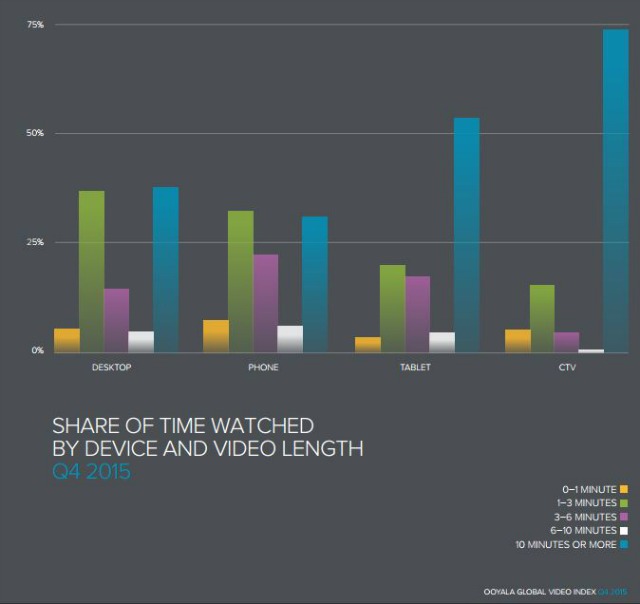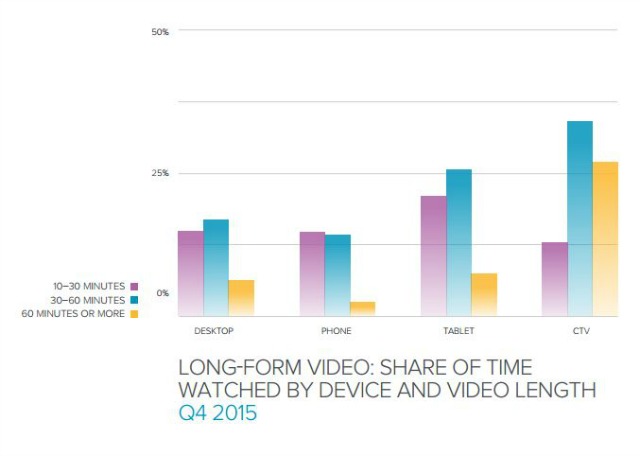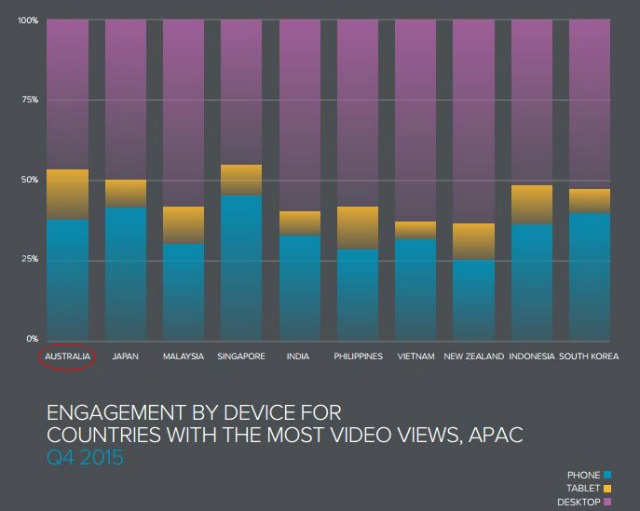Do people watch long videos? Do they watch more on their mobile devices or on the desktop? Should you still keep videos shorter for desktop viewers? If you’ve been dying to know, then I have some answers for you.
The most recent Ooyala Global Video Index suggests that 69% of videos watched on mobile phones in Asia-Pacific during October, November and December 2015 were shorter than 10 minutes.
In contrast, 54% of videos watched on tablets were longer than 10 minutes, and 21% of those were 10-30 minutes long. It seems that the larger their screens, the longer people were willing to watch videos.
The analysis is based on video metrics from global media outlets such as Foxtel, Sky Sports and ESPN were serving their mobile audiences.

Lengths of long videos (a summary)
The report shows that:
- people are happy to watch long videos
- more people are watching long videos on tablets than on mobile phones
- people watch on connected TVs when videos are longer than 60 minutes

Aussies love watching on mobile devices
For Australia, mobile views were 53%, and this could be because more and more users in our country are able to stream high-quality video.

The report also acknowledges that:
“Australia, too, has struggled with geography in deploying high-speed broadband across its expansive territory, finding mobile networks easier to establish and bring up to speed. Those robust mobile networks have helped create a thriving smartphone market.”
The bottom line…
More people are watching videos on mobile devices
Overall, a whopping 50% of video streaming in Asia-Pacific were mobile, and there’s been a year-over-year increase in mobile video plays on mobile phones and tablets combined – from 17% in 2013 to 34% in 2014 and 46% in 2015.
That’s 170% since 2013. So we’d be right to expect that more and more people will be watching videos on mobile devices in the next few years.
Don’t be so strict when choosing video length
According to the report, although viewers were watching longer videos on larger screens, they were less parochial when choosing which screen to use — whether mobile phone or tablet — and they opted to use whatever device that happened to be nearby at the time.
What does all of this mean for your small business?
Here’s what I think, both as a user and as a video script copywriter.
Think mobile
It means if you’re producing or plan to produce videos for your small business, you should focus on a mobile-first approach because your potential customers are watching on mobile devices. And consider this: Google reports that 100 million hours of “how-to” videos have been watched on YouTube so far this year. So if you have instructions to share, try sharing via (longer) videos.
If you’re on a limited budget and are unable to produce different video lengths for desktop and mobile users, simply tailor all your videos for users who would be watching on their mobile devices.
Make every second count
Mix it up to add some long videos when appropriate. If some of your viewers opt to watch on the desktop, then great. At least your videos are short enough to get straight to the point and keep their attention yet long enough to give the essential information to help them get to know, like and trust you, or to help them decide whether to accept your offer. Make every second count.
Quality is a priority
Focusing on a mobile-first approach also means you need to pay more attention to the quality of your content as well as the quality of delivery. Ensure the quality of your short and longer videos is perfect for watching once it opens on your viewer’s mobile device, especially if you’re using audio and text.
Tip: Viewers would forgive image quality if your sound is spot on. However, make sure they’re able to read and understand the text, your offer and how to respond to your call to action.
As Google likes to remind us about posting videos, video services like YouTube compress video data so it can be efficiently transmitted across the Internet to your viewers. This already tells you that your video may lose a little bit in quality just by being online.
Train viewers to watch longer videos
And while short, punchy and clear make a great video, remember that there are people out there happy and willing to watch longer videos. So you could create longer videos that aim to increase the amount of time your audience will spend watching your videos rather than always producing short-ish videos and forcing them to watch a series of videos (Part 2, Part 3 and so on). If your long videos are engaging, informative and relevant, your target audience would be happy watching all the way through.
Test, test, test!
Most importantly… although the report shows that in general people are happy to watch longer videos and that they’re happy to watch long videos on their mobile devices, what about what YOUR audience prefers? There’s only one way to find out. Test!
Test the length. Test the script. Test the offer. Test the images and audio used. Test the places where you share your videos. Test… just test.
And if all fails…
If you’re not sure why your video isn’t attracting new customers…
If you’re struggling to write video scripts that convert…
If you’re about to give up…
Then consider working with a copywriter. I can take your copy and turn it into a strong, persuasive script or just do a tune-up to make it work better. Without being too salesy, and without breaking the bank. Let’s connect.
Get in touch via email and request your FREE video script review.
Data sourced from Ooyala. The full report is available here.


Monitoring your users and insights such as device usage are useful to increase engagement with your product/website. But, I am not so sure that mobile browsing is absolutely dominant in Australia.
Recently I conducted a review of Google Analytics data from 81 of my customer’s websites which revealed that mobile web browsing has plateaued over the last couple of years to about 40% of total browsing, and that this figure doesn’t seem to be increasing. It seems to me that unless some new innovation in mobile technology is created then mobile browsing will never be predominant: http://www.yarraweb.com.au/920/the-rise-and-plateau-of-mobile-use-2010-2016/
Thanks for sharing, Patrick. Very interesting data for sure. Perhaps the main difference between your data and the regional data is the regional data focuses on larger corporations with movies, sports and reality shows, those who are on Foxtel and Telstra and the like. Your customers are not publishing the same type of content.
Right good point, for sure, consumption of content can be very device specific. I know that Facebook is consumed more on mobile devices than on desktops for example, and yes, my customers definitely are not publishing the same type of content.